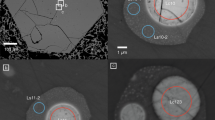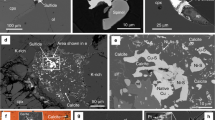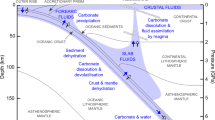Abstract
CARBONATITES are igneous rocks1 but the exact nature of carbonatite magma has not been established. Silicate magmas, both extrusive and intrusive, are molten and normally carry a low-pressure gas phase. Carbonatite magmas appear also to be molten when extrusive2 but there is evidence, in the form of brecciation and fenitization, that a gaseous phase plays a dominant role in carbonatite intrusions (see also ref. 3). We now report that a fluid medium capable of transporting carbonatitic material can exist, not as a molten liquid but as a gaseous and mobile supercritical fluid from which carbonatites can crystallize directly. Such a system is a strong contrast with the usual notion of an igneous magma.
This is a preview of subscription content, access via your institution
Access options
Subscribe to this journal
Receive 51 print issues and online access
$199.00 per year
only $3.90 per issue
Buy this article
- Purchase on SpringerLink
- Instant access to full article PDF
Prices may be subject to local taxes which are calculated during checkout
Similar content being viewed by others
References
Heinrich, E. W., The Geology of Carbonatites, 555 (Rand McNally, Skokie & Co., 1966).
Dawson, J. B., Bull. Volc., 24, 349 (1962).
Pineau, F., and Allegre, C. J., C.R. Acad. Sci. Paris, 274, 2620 (1972).
King, B. C., Le Bas, M. J., and Sutherland, D. S., J. Geol. Soc. Lond., 128, 173 (1972).
Roedder, E., in Geochemistry of Hydrothermal Ore Deposits (edit. by Barnes, H. L.), 515 (Holt, Rinehart, New York, 1967).
Roedder, E., Schweiz. Miner. Petrogr. Mitt., 50, 41 (1970).
Author information
Authors and Affiliations
Rights and permissions
About this article
Cite this article
LE BAS, M., MILLS, A. & RANKIN, A. Preliminary Evidence on the Nature and Composition of Carbonatite Magma. Nature 239, 215 (1972). https://doi.org/10.1038/239215a0
Received:
Issue Date:
DOI: https://doi.org/10.1038/239215a0



